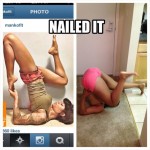Before you read on, PLEASE take ONE minute & NINE seconds to watch this video:
Coaching or training is a skill set that takes years of experience to acquire. What I want to specifically talk about here is the “Coaching Eye”. But before you we move forward to the good stuff, please watch the video, if you already have- Thanks, you’re awesome! If you haven’t yet, watch the VIDEO! 😉
Captain Obvious
The video’s quote: “It’s easy to miss something you’re not looking for” is dead on! When you’re first Coaching a team or your first personal training client, it can be very overwhelming, just like the video but worse! You’re so fixated on one thing you fail to see all the other issues, like a MOON WALKING BEAR!
This is where experience comes into play, as you develop your “Coaching Eye” you learn to be aware of the whole picture, from there movements start to slow down…Matrix anyone?
If You Build it, They Will Come:
I’ve found sprints to be the toughest to analyze in live motion. Mainly because it’s a SPRINT! The guys are moving so fast and you only have a split second to analyze the motion. I remember when I first learned speed mechanics with Jeremy Boone. He showed me a sprinter running on the track and asked me, “what did you see?” I was baffled, “ummm a guy running?” How pathetic of an answer was that?! But Jeremy was nice enough to break it down for me, step by step, and explain the phases of a sprint. I still didn’t fully grasp it all that well, but it did start to slow things down just a bit for me.

As I watched sprinter after sprinter with the guidance of Jeremy and his experience, I started to slowly build that “Coaching Eye”. This made my life a lot easier, as very simple movements started to appear in my awareness radar, a very similar situation with the picture below:

Look at this closer and you’ll see more than just the initial pic.
This gets EVEN more difficult when you add in how and what motivates your client or athlete, when to push or back down with intensity, which exercises and cues will “click”best, developing mental toughness, and so MUCH MORE!
While you maybe able to coast for a bit, your client will eventually pick up on your inexperience. This is why I believe it’s so important to work under the guidance of an experienced Coach or trainer that you mesh well with it. Without this, you’re at a major disadvantage and can miss the “Moon Walking Bear”, under the guidance of a veteran Coach and practical experience, the whole picture becomes crisp & clear. Troubleshooting movements become instinctive and quicker to spot, which is key for any Coach and Personal Trainer.
Next week, we’ll talk a litte more about what I believe is the best route to build this type of experience. In the meantime please feel free to leave any questions or comments below.


 About the Author
About the Author






[…] the athlete to exhaustion or strength gains, anyone can do obtain these simple qualities. The art of coaching is developed not just through research but in the practical field under the guidance of an […]